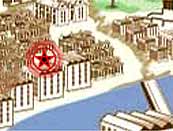 The area of Buckingham Street and Villiers Street south of the Strand is built on the site of York House.
The area of Buckingham Street and Villiers Street south of the Strand is built on the site of York House.
A palace begun in about the year 1237, York House was the London residence of the Bishops of Norwich and was originally known as Norwich Place. This Church property was confiscated by Henry VIII in 1536 and given to his then brother in law, the Duke of Suffolk.
In 1556 it became for a while the official residence of the Keeper of the Privy Seal (the equivalent of the Modern Chancellor of the Exchequer). Francis Bacon, the famous Elizabethan scientist and intellectual, was born here in 1551 and, as Keeper of the Privy Seal, lived here between 1617 and 1621.
In 1621 James Villiers, first Duke of Buckingham, the then favourite of James I, bought York House in a rather suspicious business deal and had the Watergate (supposedly designed by Inigo Jones the Architect) built in order to give him easier access by river from York House to James at the Palace of Westminster just downstream.
At this stage, and before the creation of the Embankment in the 19th century, the north bank of the river Thames was 150 yards north of its present position. Buckingham was murdered in 1628 and his widow continued to live in the Palace, now known as Buckingham House.
In the period of the English Civil War and 'Commonwealth' (1640-1660) the property was used to accommodate foreign Ambassadors and other dignitaries. In 1660 it was restored to the second Duke of Buckingham by King Charles II. The second Duke was permanently in serious debt. His contemporary, the poet Dryden, wrote of him:
"In squandering wealth was his peculiar art, nothing went unrewarded but dessert. Beggared by fools, whom still he found too late, he had his jest, and they had his estate."
Buckingham first leased the property and then in 1670 sold Buckingham House to a property speculator called Nicholas Barbon. Barbon demolished the entire property apart from the Watergate. He laid out new street plans (completed in 1674) all named after Buckingham himself; George Court, Villiers Street, Duke Street (now part of John Adam Street) and Buckingham Street itself.
Samuel Pepys moved into number 12 Buckingham Street in 1679 to live with his friend and former secretary William Hewer and lived there until 1688, when he moved next door to number 14 and where he lived until 1701, when he retired to Clapham.
Pepys' blurred, smiling phantom has been reported near the staircase of the building.
Number 14 was taken over by Robert Harley Earl of Oxford, who began the collection of his famous library here.
A succession of aristocratic families then took over number 14 until 1735 when, from that year to 1788, it became the Salt Office. Between 1824 to 1848, the painter William Etty lived in rooms at number 14 and created some of his most famous works here. Between 1824 and 1826 Sir Humphrey Davy conducted experiments into the prevention of corrosion of ships' hulls in the basement.
The eighteenth century Actress Peg Wolfington lived at number 9 Buckingham Street between 1755 and 1757, and two of the most eminent philosophers of the century, David Hume and Jean-Jacques Rousseau, briefly shared an apartment at number 10 until they quarrelled. The romantic poet Samuel Taylor Coleridge lived at number 21 in 1799 and Peter the Great, Czar of Russia, is supposed to have stayed at number 15 in 1698 during his visit to England.
Henry Fielding, the novelist and creator of the Bow Street Runners, one of England's earliest police forces, also lived at number 15 in 1735; a short walk from his offices in Bow Street just to the east of Covent Garden. The poet, painter, and writer William Morris established the Society for the Preservation of Ancient Monuments at number 9 Buckingham Street in 1878.
No 12 Buckingham Street is now home to the Regent London English Language Training School.
Other hauntings in the area:
The neighbouring number fourteen is home to a pretty female ghost, who is said to dash into the house as if late for an appointment.
 Make a date?
Make a date?
Maybe looking at the relevant clue in more detail will help? No idea how it all fits together, but I'm sure it will! »
Anything useful you discover can be posted to my message board. I'll add anything I think relevant regarding the location to this page.
